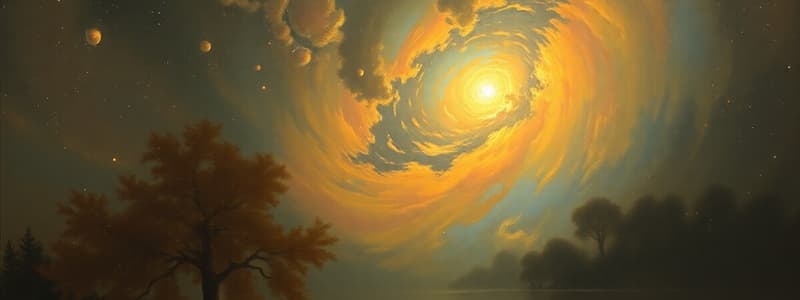Podcast
Questions and Answers
What significant process occurs approximately 3 seconds after the Big Bang?
What significant process occurs approximately 3 seconds after the Big Bang?
- Formation of protons and neutrons (correct)
- Neutrino decoupling
- Quark soup formation
- Formation of first atomic nuclei
What was the universe's temperature at the moment neutrinos decoupled from matter?
What was the universe's temperature at the moment neutrinos decoupled from matter?
- 10 trillion degrees
- 1 billion degrees
- 380,000 years
- 10 billion degrees (correct)
Which element was primarily formed during primordial nucleosynthesis?
Which element was primarily formed during primordial nucleosynthesis?
- Carbon
- Hydrogen (correct)
- Helium
- Oxygen
What is the term used for the process when protons and electrons combine to form hydrogen atoms?
What is the term used for the process when protons and electrons combine to form hydrogen atoms?
Which of the following is a fundamental force that split off first after the Big Bang?
Which of the following is a fundamental force that split off first after the Big Bang?
What is a characteristic of the universe after 3 minutes post-Big Bang?
What is a characteristic of the universe after 3 minutes post-Big Bang?
What describes the 'cosmic neutrino background'?
What describes the 'cosmic neutrino background'?
Which problem is NOT explained by the Big Bang theory?
Which problem is NOT explained by the Big Bang theory?
Flashcards
Formation of Protons and Neutrons (3 seconds after Big Bang)
Formation of Protons and Neutrons (3 seconds after Big Bang)
The moment when the universe cooled enough for quarks to combine and form protons and neutrons, crucial for the formation of atomic nuclei.
Primordial Nucleosynthesis (3 minutes after Big Bang)
Primordial Nucleosynthesis (3 minutes after Big Bang)
The process where protons and neutrons fused to form the first atomic nuclei, primarily hydrogen, helium, and a trace of lithium. This occurred when the universe cooled to around 1 billion degrees.
Recombination (380,000 years after Big Bang)
Recombination (380,000 years after Big Bang)
When the universe cooled enough for protons and electrons to combine, forming neutral hydrogen atoms. Photons began to travel freely, leading to the cosmic microwave background (CMB).
Decoupling (380,000 years after Big Bang)
Decoupling (380,000 years after Big Bang)
Signup and view all the flashcards
Cosmic Microwave Background (CMB)
Cosmic Microwave Background (CMB)
Signup and view all the flashcards
Adiabatic Expansion
Adiabatic Expansion
Signup and view all the flashcards
Flatness Problem
Flatness Problem
Signup and view all the flashcards
Horizon Problem
Horizon Problem
Signup and view all the flashcards
Study Notes
Early Universe Timeline
- 10-6 seconds: Quark Soup - The universe was extremely hot (10 trillion degrees), composed of quarks, gluons, photons, electrons, and neutrinos. These particles existed in a dense soup.
- 1 second: Neutrino Decoupling - The universe cooled to 10 billion degrees. Neutrinos stopped interacting with matter and started traveling freely. These neutrinos are detectable today.
- 3 seconds: Proton and Neutron Formation - Quarks combined to form protons and neutrons as the universe cooled. These particles were the building blocks of atomic nuclei.
- 3 minutes: Primordial Nucleosynthesis - The universe reached about 1 billion degrees. Protons and neutrons combined to form atomic nuclei (mostly hydrogen, helium, and a tiny bit of lithium). Heavier elements couldn't form due to rapid cooling.
- After 3 minutes: Hot Plasma - The universe was a plasma of atomic nuclei, electrons, and photons. Atoms couldn't yet form.
Key Concepts
- Adiabatic expansion: The universe expands adiabatically.
- Echo of the Big Bang: Recombination, decoupling, and last scattering are key to understanding the CMB.
- Recombination: Protons and electrons combined to form hydrogen atoms.
- Decoupling: Photons and baryonic matter are no longer interacting.
- Last Scattering: Photons were released and became free from matter.
- CMB Thermalization: The CMB reached equilibrium through three processes: Compton scattering, free-free scattering, and double Compton scattering.
- Big Bang Unsolved Problems:
- Flatness Problem: Why is the universe so close to flat?
- Horizon Problem: Why is the universe so uniform across vast distances?
- Monopole Problem: Why are magnetic monopoles not observed in the universe?
- Fluctuation Problem: The origin of structure in the universe.
Studying That Suits You
Use AI to generate personalized quizzes and flashcards to suit your learning preferences.




